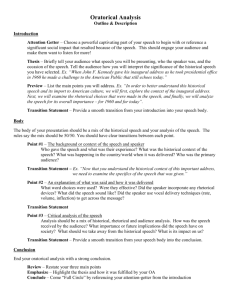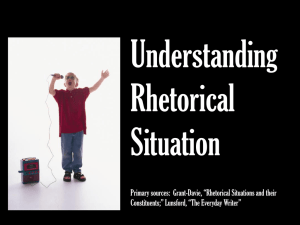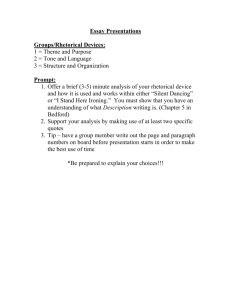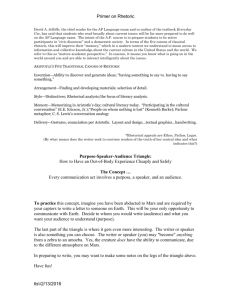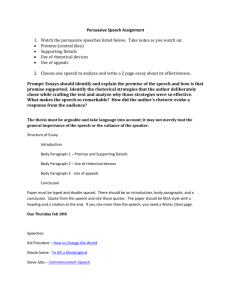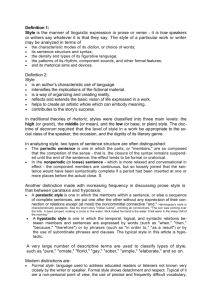Rhetorical Analysis
advertisement
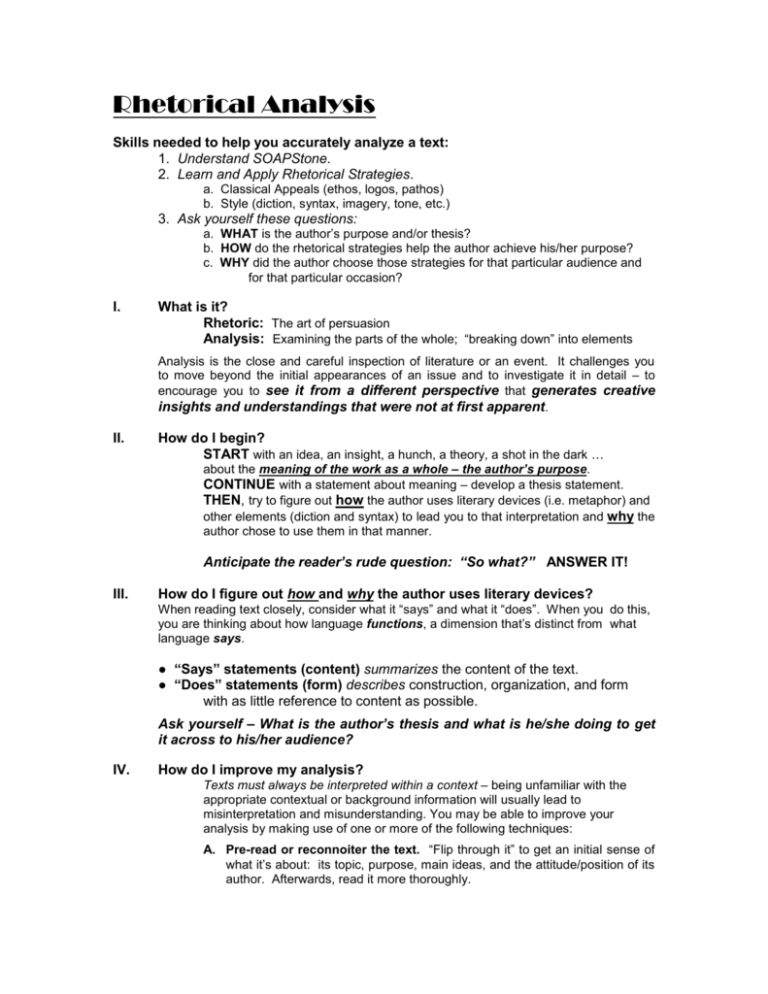
Rhetorical Analysis Skills needed to help you accurately analyze a text: 1. Understand SOAPStone. 2. Learn and Apply Rhetorical Strategies. a. Classical Appeals (ethos, logos, pathos) b. Style (diction, syntax, imagery, tone, etc.) 3. Ask yourself these questions: a. WHAT is the author’s purpose and/or thesis? b. HOW do the rhetorical strategies help the author achieve his/her purpose? c. WHY did the author choose those strategies for that particular audience and for that particular occasion? I. What is it? Rhetoric: The art of persuasion Analysis: Examining the parts of the whole; “breaking down” into elements Analysis is the close and careful inspection of literature or an event. It challenges you to move beyond the initial appearances of an issue and to investigate it in detail – to encourage you to see it from a different perspective that generates creative insights and understandings that were not at first apparent. II. How do I begin? START with an idea, an insight, a hunch, a theory, a shot in the dark … about the meaning of the work as a whole – the author’s purpose. CONTINUE with a statement about meaning – develop a thesis statement. THEN, try to figure out how the author uses literary devices (i.e. metaphor) and other elements (diction and syntax) to lead you to that interpretation and why the author chose to use them in that manner. Anticipate the reader’s rude question: “So what?” ANSWER IT! III. How do I figure out how and why the author uses literary devices? When reading text closely, consider what it “says” and what it “does”. When you do this, you are thinking about how language functions, a dimension that’s distinct from what language says. ● “Says” statements (content) summarizes the content of the text. ● “Does” statements (form) describes construction, organization, and form with as little reference to content as possible. Ask yourself – What is the author’s thesis and what is he/she doing to get it across to his/her audience? IV. How do I improve my analysis? Texts must always be interpreted within a context – being unfamiliar with the appropriate contextual or background information will usually lead to misinterpretation and misunderstanding. You may be able to improve your analysis by making use of one or more of the following techniques: A. Pre-read or reconnoiter the text. “Flip through it” to get an initial sense of what it’s about: its topic, purpose, main ideas, and the attitude/position of its author. Afterwards, read it more thoroughly. B. Skip past sections you don’t understand. If you encounter a sentence or paragraph you don’t understand, try “bouncing over” the problematic section and continue reading. You may find that a later part of the text clarifies the part you don’t understand; if not, return to the puzzling section and see if you can figure it out. C. Read purposefully and actively. You are more likely to understand a text if you engage it actively rather than passively. Annotated the text; write in the margins; highlight important points that you can use in your argument and/or essay. D. Take concise notes of main points and key information. Try to record brief notes on everything you read – collect these notes in a centralized form so that you may review them from time to time (not just the night before an exam). This strategy will not only refresh your memory but will also help you develop the kind o f conceptual background or context that will make you a better reader. SOAPStone 1. SPEAKER: Is someone identified as the speaker? Can you make some assumptions about this person? Their class? Political party? Gender? NOTE: Does the speaker evoke God? a Nation? Liberty? History? Hell? Does the speaker allude to classical themes? Why is the speaker using this type of language? 2. OCCASION: What prompted the author to write this piece? What event led to its publication or development? 3. AUDIENCE: Does the speaker identify an audience? What assumptions can you make about the audience? Mixed racial/gender group? Social class? Political party? 4. PURPOSE: What is the speaker’s purpose and how does he/she convey this message? How would you perceive the speaker giving this speech? What is the document saying? What is the emotional state of the speaker? How is the speaker trying to spark a reaction in the audience? What words or phrases show the speaker’s tone? How is the document supposed to make the reader feel? 5. SUBJECT: What is the subject of the piece? How do you know this? How has the subject been selected and presented by the author? 6. TONE: What is the author’s attitude toward the subject? What emotional sense do you take from the piece? Once you understand the information above, it’s time to begin putting your thoughts and ideas into a format that proves you have accurately analyzed the text. There are many ways to write an effective rhetorical analysis essay. We will look at a possible format to begin your essay. The Introductory Paragraph The INTRODUCTION should be a Rhetorical Precis format. The Rhetorical Precis contains four sentences that will “set up” your Rhetorical Essay. 1 __________________, _______________________, in his/her ______________________, (author’s credentials) (author’s first & last name) (type of text) argues that ___________________________________________________________ (strong verb followed by a “that” clause) 2 (state the writer’s subject after “that”) _________________’s purpose is to ___________________________________________ (author’s last name) (state what the author does in the text) in order to ___________________________________________________________ (state what the author wants the audience to do after reading the text) 3 He/she adopts a(n) __________________________ tone for ______________________. 4 He/she supports this claim by first ______________________________, then (choose a descriptive adjective) (intended audience). ______________________________, and finally ______________________________ . Sample Introduction. 1) Toni Morrison, a well-known scholar in the humanities, in her essay, “Disturbing Nurses and the Kindness of Sharks,” implies THAT racism in the United States has affected the craft and process of American novelists. 2) Her purpose is to make her readers aware of the cruel reality of racism underlying some of the greatest works of American literature IN ORDER TO help them examine the far-reaching effects racism has not only on those discriminated against but also on those who discriminate. 3) She establishes a formal and highly analytical tone with her audience of racially-mixed, theoretically-sophisticated readers and critical interpreters of American literature. 4) Morrison supports her implication by first describing how Ernest Hemingway writes about black characters and then by illustrating his strategies for plot development seen within his novels and short stories. Body Paragraphs The body paragraphs are the analysis part! The detailed explanation of strategies used by the writer is known as CONCRETE DETAILS. When writing an analysis, it is crucial that you work chronologically through the text – start at the beginning of the text and work your way through it by discussing what the writer is saying and the effectiveness of the strategies he/she is using at the beginning, middle, and end of the text. Sometimes this means that you will discuss each paragraph (one at a time), and sometimes this means that you will divide the text into sections and discuss the beginning, middle, and end of the text. Whether you discuss each paragraph or each section depends on the length and organization of the text itself. To help you move chronologically through the text, there are transition words you can use. A few of them are listed below as well as many more in this packet: shifts to juxtaposes contrasts moves to Your paragraph should include COMMENTARY – your interpretation, analysis, insight, feelings, reflection, etc. You need more commentary than concrete details. Remember to: ● Identify the part of the text you are analyzing by using transition words and strong verbs to explain what is being said. ● Identify the strongest rhetorical strategies used in that particular section. This includes incorporating specific text examples (exact words from the text) in your words and/or citing direct quotes. DO NOT try to discuss every strategy the writer uses – pick the strongest! ● Clearly and specifically explain how the rhetorical strategies are used to help the writer achieve his purpose and reach his audience. We will work on a “Pearl Necklace” activity to reinforce these points. Sample Body Paragraph. 1) The first sentence identifies which section of the text you are discussing and the main idea of that section. (Writer’s last name) (transition word) his/her (type of text) by (strong verb) that (main idea of this section of the text). President Reagan begins his tribute to the Challenger astronauts by acknowledging that the shuttle accident has appropriately postponed his planned State of the Union address and by expressing the depth of his and his wife’s personal grief. 2) The second sentence conveys the writer’s support for the main idea by identifying and providing CONCRETE EXAMPLES for ONE strategy used by the writer. This sentence is repeated if more than one rhetorical strategy is used. He appeals to the mournful emotions of the audience by admitting that he and Nancy are “pained to the core” (3), that today is rightfully a “day for mourning and remembering” (2-3), and that the accident is “truly a national loss” (4). 3) and 4) The third and fourth sentences should contain COMMENTARY – your interpretation, analysis, insight, feelings, reflection, …) REPEAT #2, 3, and 4 above. 5) … A CONCLUDING SENTENCE THAT TRANSITIONS INTO YOUR NEXT BODY PARAGRAPH. Concluding Paragraph ● The concluding paragraph should all be commentary. ● DO NOT repeat key words from anywhere in the essay. ● Leave your reader with a statement that is “satisfying” …


